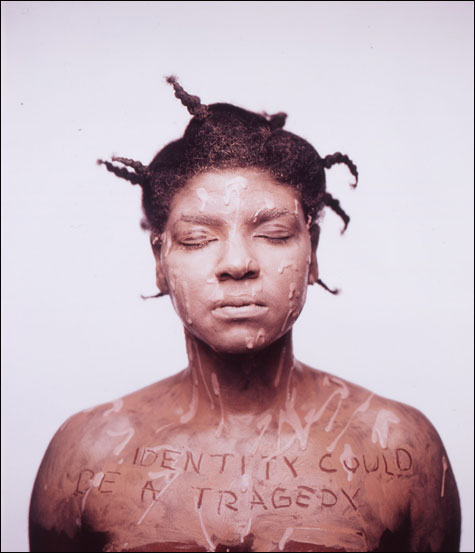
“IMAGES, ICONS, AND IDEOLOGIES” María Magdalena Campos-Pons’s When I Am Not Here/Estoy
Allá is part of “Black Womanhood” at Wellesley’s Davis Museum.
Hundreds of handmade English dollhouses, collected over the past 20 years, brightly lit and set out in a darkened gallery space, will form the heart of “RACHEL WHITEREAD” at the Museum of Fine Arts (465 Huntington Ave, Boston; October 15–January 25), the artist’s first solo museum exhibit in the US since 2001. The installation continues Whiteread’s investigation into the places where architectural and psychological space collide; it’s accompanied by related sculpture and rarely seen drawings. The MFA also has ancient civilization in its sights this fall, digging into the past in “ART & EMPIRE: TREASURES FROM ASSYRIA IN THE BRITISH MUSEUM” (September 21–January 4), with monumental carved wall reliefs and small ivories, bronzes, and tablets from ancient Assyria (modern-day Iraq) dating from the period between the ninth and seventh centuries BC.

Cultural history gets physical, and political, in “BLACK WOMANHOOD: IMAGES, ICONS, AND IDEOLOGIES OF THE AFRICAN BODY" at Wellesley College’s Davis Museum and Cultural Center (106 Central St, Wellesley; September 17–December 14), a show that explores a powerful icon in contemporary art — the black female body — and the perpetuation of symbols and stereotypes through three lenses: traditional African objects, Western colonial-era images, and works by contemporary African and African-descended artists including María Magdalena Campos-Pons, Lalla Essaydi, and Renée Cox, along with a slew of emerging and established artists from around the world. At the same time, the Davis Museum will show “ELLEN ZWEIG: HEAP” (September 17–December 14), a series of six videos portraying Western thinkers influenced by Chinese culture, among them German philosopher G.W. Leibniz and Dutch mystery writer Robert van Gulik. And the culture of Renaissance marriage is the subject of “THE TRIUMPH OF MARRIAGE: PAINTED CASSONI OF THE RENAISSANCE” at the Isabella Stewart Gardner Museum (280 the Fenway, Boston; October 16–January 18), a scholarly look at how elegantly painted wedding chests, or “cassoni,” offer insight into social and gender roles of the era.
Adventurous 19th- and early-20th-century artist explorers, fascinated by the remote vistas of the Arctic and Antarctic, were inspired to travel thousands of miles to experience the farthest limits of geography and imagination for themselves. Images of the poles created by painters including Frederic Church and Rockwell Kent are on view in “TO THE ENDS OF THE EARTH, PAINTING THE POLAR LANDSCAPE” at the Peabody Essex Museum (East India Square, Salem; November 8–March 1). The works reveal the influence of both the romantic sublime approach to landscape and early modernist concerns.
The landscape of the mind preoccupied poets as well as painters in the 1920s, when Surrealism, stimulated by the theories of Sigmund Freud, delved into the realm of the unconscious, particularly as expressed through our dreams. “INVISIBLE RAYS: THE SURREALISM LEGACY” at Brandeis’s Rose Art Museum (415 South St, Waltham; September 26–December 14) looks at historical and contemporary aspects of the subject, with more than 30 works from the Rose’s permanent collection, by artists ranging from Roberto Matta and Yves Tanguy to Tracey Moffatt and Jessica Stockholder. Also opening on September 26 at the Rose, “PROJECT FOR A NEW AMERICAN CENTURY” unveils new works that have entered the museum’s collection in the past three years (disclosure notice: it’s curated by me), and “DRAWING ON FILM,” organized by the Drawing Center in New York, surveys the practice of drawing, scratching, or otherwise manipulating film stock to create images without a camera.
Familiar, found materials including old billboard signs and traffic cones make up the multimedia experience “JUAN ÁNGEL CHÁVEZ: SPEAKER PROJECT” at Mass College of Art (621 Huntington Ave, Boston; September 22–November 22), which turns the gallery into an interactive sound studio. Also at MassArt this fall, color photographs of forgotten corners of the American South evoke memory and myth in “WILLIAM CHRISTENBERRY PHOTOGRAPHS, 1961–2005” (October 13–December 6).
Huge volumes of a single type of mass-produced item — for example, millions of drinking straws, or scads of pins, buttons, styrofoam cups, or toothpicks — make up the sculptural works on view in “TARA DONOVAN” at the Institute of Contemporary Art (100 Northern Ave, Boston; October 10–January 4), the first major museum survey of Donovan’s work. And entertaining Swiss artist UGO RONDINONE (October 28–October 19, 2009) transforms the ICA’s Fineberg Art Wall with an all-black installation, “The Night of Lead.” Everyday images and materials also figure in the work of the Paris-based artist who’s bringing “ADEL ABDESSEMED: SITUATION AND PRACTICE” to MIT’s List Visual Arts Center (20 Ames St, Cambridge; October 11–January 4). Abdessemed has created works from airplane fuselages and music stands, but he prefers to describe his art as consisting of “acts” in the public sphere, as he appropriates the streets and settings of everyday life for his projects. At MIT, he plans to create street acts in Cambridge, perhaps using local bars or bathrooms.
By freezing time, photography only makes us more aware of that dynamic dimension’s refusal to slow down. “KEEPING TIME: CYCLE AND DURATION IN CONTEMPORARY PHOTOGRAPHY” at BU’s Photographic Resource Center (832 Comm Ave, Boston; November 7–January 25) looks at photography’s ability to stop, pause, preserve, and contemplate time and the natural cycles of the sun and moon; the artists include Erika Blumenfeld and Sharon Harper.
Beauty remains a fraught term in contemporary art, an ideal we love to hate, an impulse whose joys we sometimes shun as superficial. “IN PURSUIT OF BEAUTY” at Montserrat College of Art (23 Essex St, Beverly; November 7–January 24) presents five artists at work investigating the pleasures and perils of surface pattern and the delightfully decorative.